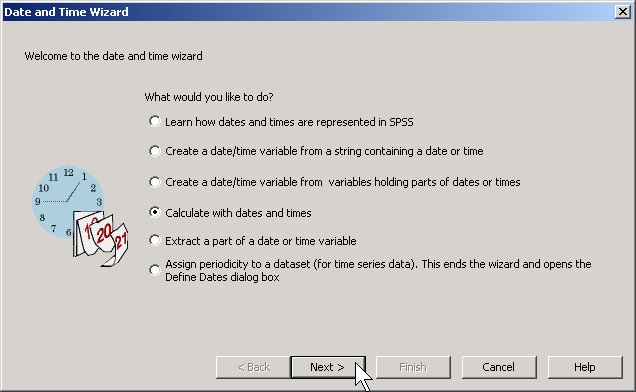
This page is moving to a new website.
Dear Professor Mean, I am trying to use dates in SPSS for certain calculations. For example, I want to use a compute statement in SPSS to create a new variable called duration of injury (durinj). I know that I must subtract the date of injury from the date of interview. However, when I do this, I get a number in the millions. What am I doing wrong? -- Stumped Sharon
Dear Stumped,
Maybe your patients were waiting for their HMO to approve a visit to a specialist.
Short explanation
SPSS stores date/time values as the number of seconds since October 14, 1582 (the start of the Gregorian calendar). If you specify only a date and not a time, then SPSS sets the time to midnight. When you subtract two dates, you get the duration of injury in seconds. Divide by 86,400 (=24*60*60) to get the duration of injury in days. Divide again by 7, 30, or 365.25 to get duration in weeks, months, or years.
More details
To see what SPSS is doing, reformat the date as a number. You will see something with a whole lot of digits. The date of 1/1/2000, for example, the date when all the antiquated software in the world will crash, is just a little more than 13 billion seconds to SPSS. Fortunately, SPSS allocates more than two digits here.
To subtract one column of numbers from another in SPSS, you select TRANSFORM | COMPUTE from the menu. Tell SPSS what name you want for this difference in the TARGET VARIABLE field. Then select the first variable and add it to the NUMERIC EXPRESSION field. Type in a minus sign (or click on the minus button in the mini calculator). Finally, select the second variable and add it to the NUMERIC EXPRESSION field after the minus sign.
If you are using dates, then this time interval is expressed in seconds. Place parentheses around the entire expression. Then place a slash at the end, followed by 86400. Dividing by 86400 changes the units from seconds to days.
Example
A common example using dates is computing length of stay in the hospital.

The data shown above represents the birthdate (dob), date of admission to the hospital (dateadm), and date of discharge from the hospital (datedsc) for newobrn babies admitted with a diagnosis of dehydration. To compute length of stay, you need to select TRANSFORM | COMPUTE from the SPSS menu.

The figure shown above is the dialog box that you get. Type in a new name in the TARGET VARIABLE field. The formula for computing length of stay is
(datedsc-dateadm)/(24*60*60)
which you should type into the NUMERIC EXPRESSION field. Then click on the OK button.

This figure shown above indicates that you have successfully computed length of stay as the difference between two date values. Congratulations.
Summary
Stumped Sharon is having problems with some calculations using dates in SPSS. Professor Mean explains that SPSS stores data values as the number of seconds since October 14, 1582. So when you calculate the difference between two date values, you see the number of seconds between the two events. Divide this difference by 86,400 (=24 hours * 60 minutes * 60 seconds) to re-express this as days.
Further reading
Raynald Levesque has a nice web tutorial about dates in SPSS.
Update
I attended a web seminar on the new enhancements in version 13.0 of SPSS software. The most notable change is in date calculations.
Date and time variables in SPSS have always been difficult. I have a web page showing some of the issues involved with computing the difference between two dates. SPSS has now added a Data and Time Wizard. Select TRANSFORM | DATE/TIME from the menu. Here's the first dialog box from that menu.

This is a very pleasant surprise, since dates are a source of constant confusion for me and for the people I work with. There were other enhancements, but to me this is the only important one.